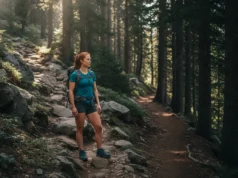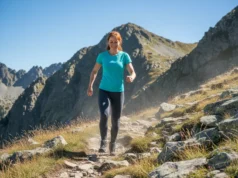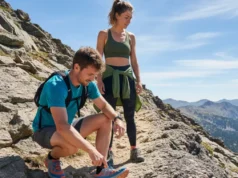In this article
Standing at the edge of a slick, algae-covered creek crossing on a wet trail, the difference between a confident stride and a dangerous slip isn’t just about luck—it’s about the engineering on your feet. Choosing the best amphibious hiking footwear for both hiking and water is a game of trade-offs, where improvements in toe protection often cost you in weight and drainage. This guide cuts through the noise with a standardized, data-driven framework—our Amphibious Performance Scorecard—to help you choose the right hiking and water shoes, not just for the trail ahead, but for the way you hike it. We’ll explore the waterproofing paradox and why breathable, non-waterproof shoes with excellent quick-drying ability are almost always superior for activities involving full water submersion. You’ll discover why the “best” shoe is different for a canyoneer, a thru-hiker, and a casual traveler, and find our top picks for each. We will decode the outsole, understanding how rubber compounds like Vibram and lug design are the real secrets behind reliable wet and dry traction. Finally, we’ll introduce the performance scorecard, detailing the five core metrics we use to quantitatively score every shoe, from Drainage Speed to Durability.
How to Choose the Right Hiking and Water Shoes: An Expert’s Framework
Why is Drainage More Important Than Waterproofing?
One of the most common mistakes I see hikers make is choosing waterproof shoes for wet environments, especially for activities like kayaking or canyoneering. It seems logical, but it creates a dangerous situation I call the “Bathtub Effect.” Once water inevitably overtops a waterproof membrane like Gore-Tex during a deep stream crossing, it gets trapped inside. Your shoe becomes a heavy, waterlogged bucket that won’t dry out. This constant moisture is not just uncomfortable; it’s a direct path to serious foot health issues like blisters, skin maceration, and in severe cases, trench foot. True water-ready design, often found in the best water shoes with breathable mesh uppers, works on the opposite principle. These non-waterproof hiking shoes with integrated drainage ports are designed to evacuate water almost instantly. They embrace the water, allowing it to flow in and out, so your feet can begin drying immediately. For any true amphibious adventure, the goal is not to stay dry, but to get dry as quickly as possible, which is a key factor in preventing blisters.
Pro-Tip: After a deep water crossing in non-waterproof shoes, take a moment to pump your feet up and down on the bank. This simple action helps to squish out the excess water held in the foam and fabric, dramatically speeding up the drying process as you continue to hike.
How Do Outsole Compound and Lug Design Dictate Traction?
A shoe’s ability to grip the ground is determined by a system of two critical factors: the chemical formula of the rubber compound and the physical architecture of the tread, or lug design. There’s an inherent trade-off between grip and durability. Softer, stickier rubber compounds like Astral’s G.SS Rubber provide phenomenal, grippy friction on smooth, wet rock or boat decks, but they wear down much faster on abrasive terrain like lava rock. Conversely, harder rubber compounds will last for hundreds of miles but offer less purchase on slick surfaces. The lug design must match the terrain. Deep, widely-spaced lugs are engineered to bite into soft ground like mud or loose soil, shedding debris as the shoe flexes. For hard, wet surfaces like riverbeds or rocky shores, you want the opposite: shallow, high-surface-area lugs, often featuring tiny slits called siping, which increase the rubber’s surface area and improve friction. Some specialized designs even incorporate features like “climbing zones” at the toe for technical scrambling and aggressive “heel brakes” for controlling descents, all part of choosing the right type of hiking footwear.
What is the Trade-Off Between Comfort, Support, and Weight?
While the outsole connects you to the trail, the midsole is what protects you from it. This is the source of cushioning and stability, typically made from foams like EVA or polyurethane. The thickness of this layer, known as “stack height,” presents a classic trade-off. A high stack height provides maximum cushioning, absorbing impact over long miles, but it can also feel less stable and reduce your “ground feel,” or your foot’s ability to sense the terrain. A low stack height, common in minimalist trail running shoes, offers excellent ground feel and stability but minimal protection from sharp objects underfoot, often leading to a lack of padding on rocky terrain. Every feature—from arch support and cushioning to toe protection and durable materials—comes at a cost, and that cost is weight. Even a few ounces can make a massive difference in fatigue over the course of a 20-mile day. Remember that true support isn’t just about cushioning; it also comes from a secure heel cup and a reliable closure system that locks your foot in place, preventing the internal slippage that causes blisters. This balance is central to The choice between trail runners and hiking shoes.
Pro-Tip: When trying on shoes, pay close attention to the heel lock. With the shoe unlaced, slide your foot forward until your toes touch the front. You should be able to comfortably slide one finger, and no more, between your heel and the back of the shoe. This ensures you have enough room for foot swell without allowing for excessive, blister-causing movement.
Our Selection Process: How We Built This Guide
To build this guide, we committed to a process of complete objectivity. We began by developing a standardized evaluation framework based on quantifiable performance metrics, allowing us to move beyond vague descriptions and score every shoe on a consistent 1.0-5.0 scale. Every product you see here was judged against five core performance criteria: Wet & Dry Traction, Drainage & Drying Speed, Hiking Comfort & Support, Foot Protection, and Durability & Construction. Our selection process involved two distinct phases. First, we aggregated extensive data from professional gear reviews and thousands of points of real-world user feedback to identify the top contenders across all footwear types, from hiking sandals and neoprene booties to dedicated water shoes. Second, we curated that final list to match the specific needs of three core user personas—the Hard-Use Adventurer, the Versatile Traveler, and the Ultralight Thru-Hiker—ensuring every recommendation is purposeful and directly relevant to a specific use case for men and women. Please note that if you purchase through links in this article, we may earn a small commission at no extra cost to you. This helps support our work, but rest assured our recommendations are always based on performance, not profit.
The Best Hiking and Water Shoes of 2025: Our Top Recommendations for Every Need
Our Top Picks for The Hard-Use Adventurer
This user is the professional guide, the dedicated canyoneer, or the serious whitewater kayaker. They operate in high-consequence environments for activities like rafting and coasteering where gear failure is not an option. Their footwear must provide maximum foot protection from unseen hazards on riverbeds, uncompromising grip on slick and treacherous surfaces, and robust durability to withstand constant abrasion. For this serious adventurer, factors like weight and casual style are distant secondary concerns to raw, reliable performance and safety.
Our Top Picks for The Versatile Trail-to-Town Traveler
This user needs a single piece of footwear that can do it all. They are the adventure traveler, the weekend warrior, or the family on vacation who might hike to a waterfall in the morning, go SUP boarding in the afternoon, and walk to dinner in the evening. For them, versatility is king. They need a shoe that performs capably on a moderate trail, drains and dries quickly after being submerged, and has a style that doesn’t look out of place in a casual setting. They are willing to sacrifice peak performance in any single category to gain the ultimate “one-shoe quiver” for their multi-sport adventures.
Our Top Picks for The Ultralight Thru-Hiker
This hiker’s world revolves around a spreadsheet. Every single item in their pack is weighed, and every decision is optimized for efficiency over thousands of trail miles. For them, foot health is paramount, and that means keeping feet as dry as possible to prevent blisters and other issues. They will gladly sacrifice the robust protection and long-term durability of a traditional boot for a shoe that is feather-light and dries out in minutes, not hours. Their footwear, often a pair of non-waterproof trail running shoes like the Altra Lone Peak, is a tool for conserving energy and maintaining the relentless pace required for summer hiking and completing a long-distance trail.
Conclusion
Choosing the right amphibious shoe is ultimately an exercise in understanding compromise. The “best” option is a direct reflection of your primary activity and personal priorities. For any adventure that guarantees full submersion, always prioritize rapid drainage and quick-drying materials over any waterproof membrane. Remember that reliable traction is a two-part system: the stickiness of the rubber compound and the mechanical grip of the lug design must be matched to the terrain you’ll face most often. Finally, treat weight as the price you pay for features. Select the lightest possible shoe that still meets your non-negotiable requirements for safety, support, and protection. Armed with this framework, revisit our top picks for your hiker persona and choose the shoe that will confidently carry you through your next wet-and-dry adventure.
Frequently Asked Questions about Hiking and Water Shoes
Are waterproof hiking shoes good for river crossings?
No, for deep river crossings where water will inevitably go over the ankle, waterproof shoes are a poor choice. They trap water inside, creating what we call the “bathtub effect,” which makes the shoe heavy and extremely slow to dry. This prolonged dampness is a primary cause of blisters and other foot issues. A far better option is a non-waterproof, fast-draining shoe that allows water to escape quickly so your feet can begin to dry while you hike.
What is more important for traction: the rubber compound or the lug design?
Both are critically important and function as a system; you can’t have good traction without both elements working together. The rubber compound determines the chemical “stickiness” of the outsole, which is crucial for gripping smooth surfaces like wet rock. The lug design provides the mechanical grip, with deep, spaced-out lugs that bite into soft terrain like mud and shed debris. The ideal shoe has a compound and lug pattern specifically designed for the environment it will be used in.
Can I just use my trail runners as water shoes?
Yes, absolutely. In fact, this is the preferred strategy for many experienced long-distance and ultralight hikers. A pair of non-waterproof trail runners with a breathable mesh upper, like the Altra Lone Peak, will drain water almost instantly after a creek crossing and will dry remarkably quickly from your body heat and ambient air as you continue to hike. This makes them an excellent and efficient amphibious tool, saving you the weight and hassle of carrying a separate pair of water shoes.
What is the difference between a water shoe and a hiking sandal?
A water shoe is typically a closed-toe piece of footwear made from mesh and other fast-drying synthetic materials. It offers more foot protection from debris and impacts and provides a more secure, athletic fit than a sandal, making it suitable for more dynamic activities. A hiking sandal prioritizes maximum ventilation and uses a system of straps to secure the foot. However, modern hybrid models, like the KEEN Newport H2, blur the lines by incorporating robust toe protection and a supportive, hiking-shoe-like sole, offering a blend of both categories.
Risk Disclaimer: Hiking, trekking, backpacking, and all related outdoor activities involve inherent risks which may result in serious injury, illness, or death. The information provided on The Hiking Tribe is for educational and informational purposes only. While we strive for accuracy, information on trails, gear, techniques, and safety is not a substitute for your own best judgment and thorough preparation. Trail conditions, weather, and other environmental factors change rapidly and may differ from what is described on this site. Always check with official sources like park services for the most current alerts and conditions. Never undertake a hike beyond your abilities and always be prepared for the unexpected. By using this website, you agree that you are solely responsible for your own safety. Any reliance you place on our content is strictly at your own risk, and you assume all liability for your actions and decisions in the outdoors. The Hiking Tribe and its authors will not be held liable for any injury, damage, or loss sustained in connection with the use of the information herein.
Affiliate Disclosure: We are a participant in the Amazon Services LLC Associates Program, an affiliate advertising program designed to provide a means for us to earn advertising fees by advertising and linking to Amazon.com. As an Amazon Associate, we earn from qualifying purchases. We also participate in other affiliate programs and may receive a commission on products purchased through our links, at no extra cost to you. Additional terms are found in the terms of service.





